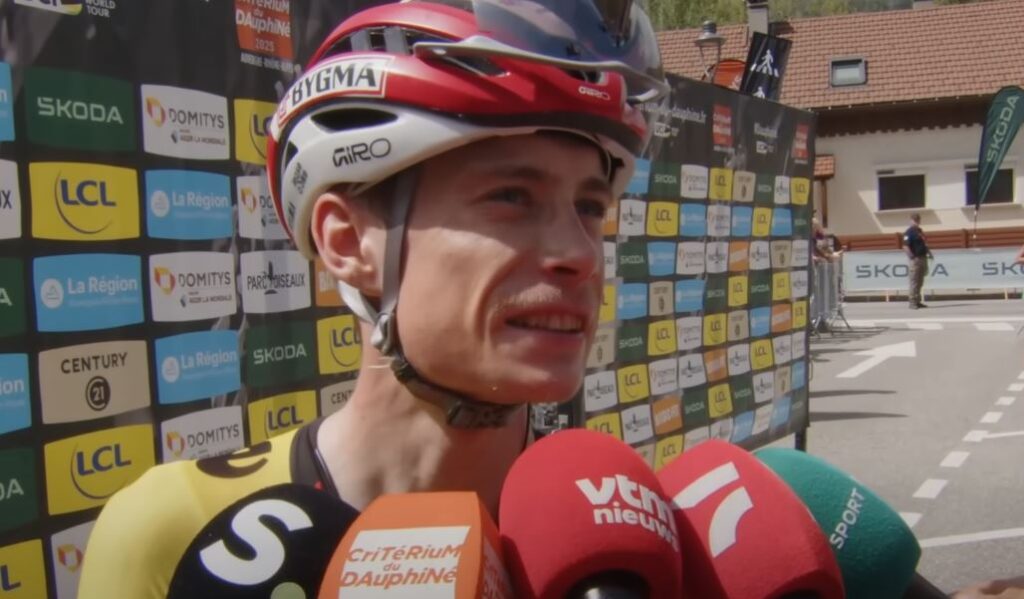
Sports occasionally give birth to a name that goes beyond podiums, finish lines, or yellow uniforms. The story of Jonas Vingegaard’s net worth is remarkably representative of that transformation. It’s worth analyzing Vingegaard’s journey, both financially and symbolically, from slicing fish in a Danish factory to hoisting cycling’s most prestigious trophies. His earnings, which are a combination of prize money, brand deals, and endorsements, have solidified his position as one of the top cyclists in terms of both performance and compensation.
His annual compensation has increased dramatically over the last three years, rising from €2.9 million in 2023 to an astounding €4.5 million by 2025. This places him just behind Tadej Pogačar as the second-highest paid professional cyclist. However, the revenue generated by races alone is only a small part of the larger ecosystem that supports Vingegaard’s wealth. He has attracted sponsorships from mainstream retail and lifestyle industries in addition to traditional cycling circles by utilizing his worldwide brand appeal. In addition to increasing his net worth, this diversification has been incredibly successful in forming his media persona.
Jonas Vingegaard | Personal, Career, and Net Worth Details
| Attribute | Details |
|---|---|
| Full Name | Jonas Vingegaard Hansen |
| Date of Birth | December 10, 1996 |
| Birthplace | Hillerslev, Denmark |
| Height/Weight | 1.75 m / 58 kg |
| Nicknames | Vingo, The Fisherman, The Rush of the Limfjord |
| Current Team | Visma–Lease a Bike (UCI WorldTeam) |
| Specialization | Climber, All-rounder |
| Major Wins | Tour de France (2022, 2023), Critérium du Dauphiné, Tirreno–Adriatico |
| Annual Salary (Est.) | €4.5 million (≈ $4.9 million) |
| Net Worth (Est.) | $6 million – $8 million (as of 2025) |
| Endorsements | Red Bull, Oakley, Shimano, Cervélo, Santini |
| Instagram Income (Est.) | $312.5K – $428.2K annually |
Vingegaard’s unwavering character—calculating but modest, reserved but explosive on the pedals—was leveraged by companies like Red Bull and Oakley through strategic alliances. His endorsement of companies that prioritize resilience in addition to performance has been especially inventive; this theme is ideally suited to his 2024 comeback following the crash. In addition to sending him to the hospital, his punctured lung and fractured ribs changed the public’s perception of him from champion to warrior. Vingegaard’s decision to withdraw from the Vuelta and the World Championships in August 2024, citing exhaustion, is no accident. He was recalculating, not running away.
These days, this kind of brand-consistent authenticity has proven especially useful for making money off of celebrity without going overboard. Even though his Instagram following is small in comparison to entertainment influencers, it brings in up to $35.7K every month. His posts’ deliberate restraint—more race clips than product endorsements—has given his feed an incredibly genuine appearance, which is advantageous for marketers tired of phony engagement metrics.
Because of his genuineness, he bears a striking resemblance to figures such as Lionel Messi and Roger Federer, who were athletes who achieved stoic consistency and amassed net worths that reached the tens of millions. That degree of permanence is starting to be echoed by Vingegaard’s presence in cycling. However, whereas Messi had Adidas and Federer had Rolex, Vingegaard’s collaborations, such as those with Cervélo and Shimano, are more a reflection of his discipline’s aerodynamic requirements than of commercial glitz. Ironically, his groundedness is what makes him so adaptable in brand crossovers, particularly for campaigns that emphasize resilience, mental health, and comeback stories.
In the realm of sports finance, the economic revival of road cycling significantly contributes to Vingegaard’s ascent. The amount of money flowing into Grand Tours has increased dramatically over the last ten years due to factors like luxury sponsorships, TV broadcasting rights, and data-driven audience targeting. Once regarded as a niche event outside of Europe, the Tour de France now attracts audiences on par with Formula 1 worldwide, thanks in large part to streaming availability. One of the faces of this financial transformation was Vingegaard, who won in 2022 and 2023 and came in second by a slim margin in 2024. He is a shareholder in the development of its culture, not merely a participant.
Vingegaard’s fortitude also changed the way people saw Scandinavian athletes, who were previously thought to be quiet or emotionally aloof. In addition to being emotionally poignant, his 2024 post-stage 11 quote, “Three months ago, I thought I would die,” went viral. It penetrated broadcast recaps and social media algorithms, ingraining itself in the public consciousness as an instance of vulnerability uncommon in high-performance sports. His wealth was increasing not only because he was quick but also because people identified with his vulnerability.
His path is still instructive for young cyclists who aspire to wear yellow jerseys. Once borrowing mismatched bikes and riding up simulated climbs at local events, the Hillerslev boy is now worth millions of dollars and is revolutionizing the way endurance sports are made profitable. His pay breakdown, which is almost €86,500 per week, is a startling turnabout from his days working in a fish factory. He used to skin cod for hourly pay, but now he could earn over $100,000 in prize money and bonuses from a single Alps sprint.
Nevertheless, Vingegaard continues to function very differently from the cycling greats of the past, even with his elite status. Chris Froome‘s reputation declined due to team politics and mechanical mishaps, while Lance Armstrong’s wealth increased during scandal. Vingegaard, on the other hand, has maintained his quiet dominance; he is almost monastic in his routines and rarely scandalous or political. Given that he is now a father of two, European brands looking for stability and family-friendly appeal will find this profile especially valuable.
